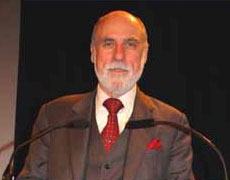
Google reveals what it would do running the Postal Service
The postal sector asked the question yesterday, “What Would Google Do?” if it was running the struggling US Postal Service. And Google came back with a reply. Yesterday saw a fascinating event held in Arlington, Virginia, in which the postal sector grilled various internet and digital gurus to grasp some idea of how the physical mail industry should be responding to the digital revolution.
Among the respected experts sharing their views at the PostalVision2020 conference was Google’s vice president and “co-founder of the internet”, Vint Cerf.
And while there was much talk during the day about various potential for the USPS to move into new digital forms of communications, the Google vice president said that actually, the internet search giant would probably take advantage of the unique asset of the USPS if it was running the agency.
The unique asset he highlighted was the USPS physical delivery network, and the fact that the organisation’s mail carriers visit virtually every American home six days a week.
“I am convinced that until we get to the 24th Century, we are going to need the Postal Service as somebody to provide delivery services,” he said. “But since you are walking past every single mail box every day, except Saturday – is there anything else you can do with that feature?”

Google vice president and chief internet evangelist Vint Cerf highlighted the Postal Service’s unique connection to almost all American homes and businesses
Cerf, who has received medals from two American Presidents for his pioneering work in the internet field, said if the Postal Service was going to survive, it would have to find new lines of profit.
But he advised: “If there is something the Postal Service can do with its footprint, it should be physical.”
He did discuss the possibilities of electronic mail, though he noted that his own involvement in the commercial email service MCI Mail had been killed off by free email services.
Cerf said he believed profits in delivery services in the future would be mainly found in overnight delivery, but also stated his belief that the US Postal Service could set itself up as an important trusted third party to provide the physical aspect of verification services, including certifying people through its Post Office network to ensure that individuals on the internet are who they say they are.
The role of USPS
Jeff Jarvis, the journalist whose book “What Would Google Do?” inspired yesterday’s event organised by mail industry association PostCom and postal consultancy Ursa Major Associates, suggested a more fundamental re-think was needed on the role of the Postal Service in the digital age.
But his particular warning was that the without a clear idea what kind of business it was in, USPS could flounder like other giants have already in the digital world.
“AOL was Facebook before Mark Zuckerberg even started shaving,” he said. “But they asked the wrong question about what business they were in. They thought they were in the entertainment industry, merged with Time Warner, started making movies. They were wrong.”
Jarvis, a blogger and associate professor of interactive journalism at the City University of New York, said that judging from the experience of newspapers, the Postal Service should not attempt to move into digital communications through incremental change, but make a bold step.
“The newspapers went in to digital step by step, and that failed,” he said. “I just spent two days with a newspaper that thought it had gone through everything the right way – and it now has to cut itself in half.”
Making the most of the physical address
Larry Weber, who founded the world’s largest PR agency Weber Shandwick before stepping out to form a new firm focussed on digital communications, W2 Group, also advised the Postal Service to build on its unique assets, in particular its valuable physical address database.
Weber, whose career has included leading the global marketing of HTML, said there were “huge opportunities” for the Postal Service in the current boom in social media, although he said collaborative working would be key to its success.
And, with the world of marketing rapidly moving towards a basis on personal recommendations from consumer to consumer, rather than broadcasted messages, Weber suggested there could be particular potential for the Postal Service in a social network based around the change-of-address system.
“By far the most important way people are make purchasing decisions is by recommendation,” he said. “The important thing with this social network is that when I move, in my new place I want to know where my friends go, what they do.
“I don’t think it would be complex,” he added. “It would be protected, secure. You change your address, and now you can get a lot of offers.”
Platforms and sandboxes
Yesterday’s PostalVision2020 event saw a number of people stressing the benefits of collaborative working and for the USPS to encourage independent entrepreneurs to get involved with its digital development.
The USPS should be an enabler of digital communications, rather than a provider, said various speakers and delegates – opening up its platform for independent developers to benefit and benefit from the platform, as has been seen in Apple’s iPhone and Google’s Android platforms.
With suggestions at the event that the USPS should look to get into areas of innovation closed to private sector developers, Jennifer Tomlinson of Canada Post-owned IT technology firm Innovapost said the address database would prove a “critical” asset for a Post in the digital age.
She said: “The private sector can provide digital platforms, but there are gaps in what they can provide. A digital platform linked to the physical, for example. Facebook can tell you everything about what someone is doing, but can’t tell you where they are living.”
Marshall van Alstyne, an associate professor at Boston University, who particularly supported the concept of the platform, spoke of the need for USPS to create a “sandbox” in which independent developers could try things and innovate with a USPS digital service.
He said a USPS platform should look to combine different applications, in the same way that Apple’s iPhone now offers phone calls, videos, an MP3 player, electronic books and various other options. “Apple has been killing standalone platforms,” he said. “Microsoft’s Zune MP3 Player was killed off, and now the iPad has come along and the Kindle’s revenues have dropped 22%.”
van Alstyne said the USPS platform could build on partnerships with telecoms and broadband companies, banks and bill paying systems, secure electronic communications and permission-based advertising.
“Don’t just have a product strategy,” he said, “You need a platform strategy to survive in the digital world.”













I’m sorry but I loved all the comments in this article on how and what the USPS should do in the digital age. Why? Because not a single person knows anything about what they are talking about. Her is why. In the late 90’s the USPS came up with a bunch of e-activities and initiatives. In September of 2000 the Government Accountability Office issued a report to Congress on the plans for USPS e-activities. Congress held an oversight commitee meeting to go over these. Among the people who testified that the USPS should not be allowed to enter the e-commerce sector
was the then CEO of UPS. He testified against the USPS and Congress agreed that the USPS should not be aloowed to ebter these markets. Congress also made it AGAINST the law for the USPS to do anything other than deliver hard copy mail. Here are some highlights of this report from Sept 2000.
*USPS introduced the
PosteCS initiative, an Internet-based global document delivery system
*USPS introduced its eBillPay initiative, an electronic bill presentment and
payment service, in April 2000.
*For example, USPS has identified
an electronic mailbox, which is a concept in the early development stage
that could link electronic and physical addresses, as an infrastructure
initiative. (YEAR 2000)
*some competitors and others contend that USPS should refrain
from entering markets currently being served by the private sector and should limit its activities to providing hard copy delivery services.
*Members of Congress and postal stakeholders have raised issues related to the meritsof USPS’ development of nonpostal products and services, including those
that are e-commerce related
here is the link to this report. http://www.gao.gov/archive/2000/gg00188.pdf
You’re absolutely right, Brian, to say that getting Congressional approval is a major part of the battle for USPS – and this point was made several times during PostalVision.
Also, that the USPS has tried electronic services before (the certified email was mentioned), but that they were killed off by Congress, or were “ahead of their time” in terms of the consumer engagement with the internet.
I think one of the points of the event’s brainstorming was that to get Congressional approval, first proposals must be pitched with which to persuade them to act.
Also, a key point was that in the past USPS has sought always to own the innovation and act as a sole provider of the innovative services, determining exactly what those services are and how people use them. There was some discussion at PostalVision that to compete in today’s digital world the USPS needs to be more of an enabler for others to innovate, through a more collaborative approach with independent developers and allowing users to determine the best uses for a USPS digital platform.
Bringing in non-postal digital experts was effectively part of getting an outside perspective on the digital issue.
Interesting article! But as a city mail carrier for the last 24 years, there is no way USPS will last beyond my 30 year retirement.
USPS is a backward(s) moving bureaucracy that wastes so much money, it’s doomed to fail.
The recent implementation of it’s FSS (Flats Sequence Sorting) System cost the USPS nearly $1 billion dollars.
These FSS machines sort magazines in walk sequence order, so that we carriers no longer have to manually sort the flat/magazine mail.
These machines were ordered before the drastic declines in mail volume, and now there is hardly anything beyond the discounted bulk rate mail going through these machines!
These FSS machines constantly break down, destroy the few magazines coming through, cannot read hand written envelopes, and are already becoming obsolete!
A couple of times we didn’t even get FSS mail, because the machines were broken! On the following days we got double mail, but some of the magazines look like they have gone threw a shredder!
With the increasing popularity of Apple’s iPad and all the other tablet makers, you can instantly download the latest issue of your favorite magazine directly to your device.
No more shredded, rain soaked, mis-delivered, and/or late magazines!
This type of waste is nothing new in my nearly quarter century with this organization. There have been many other multimillion dollars disasters.
A few years back, the USPS purchased electric vehicles, installed electric charging stations in every parking stall, and got rid of our gas vehicles.
The only problem was the new electric vehicles all had defective batteries! So they had to dump those vehicles and purchase a bunch of gas powered Ford Windstars.
Now the Windstars are parked right next to the rusting electric terminals. How’s that for forward thinking?
And the new FSS system…looks like nearly another billion bucks down the USPS drain!